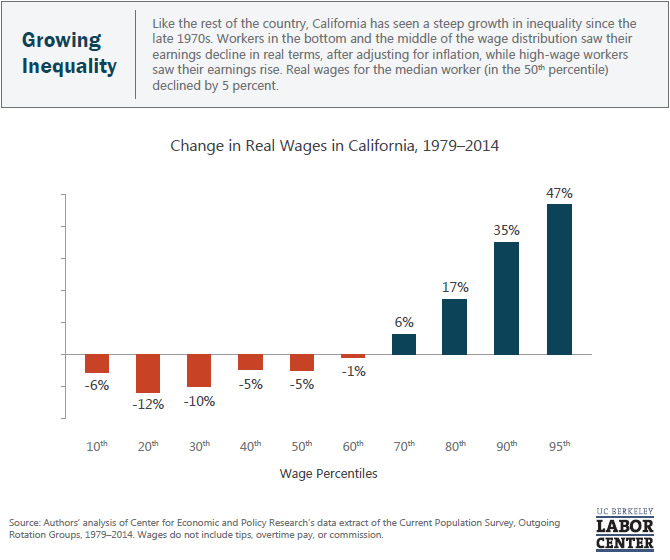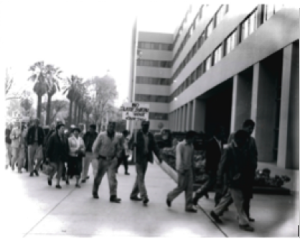
 Last Thursday, the UC Berkeley Center for Labor Research and Education released Low Wage Work in California: 2014 Chartbook, its most recent study of earnings in California. Among the chief findings: the gap continues to grow between the low wage workforce and the rest of the California workforce.
Last Thursday, the UC Berkeley Center for Labor Research and Education released Low Wage Work in California: 2014 Chartbook, its most recent study of earnings in California. Among the chief findings: the gap continues to grow between the low wage workforce and the rest of the California workforce.
The study drew on Census Bureau data on low wageworkers, defined as those earning hourly wages of $13.63 an hour or less. This low wage workforce constituted 4.7 million workers in 2014. The chart above provided by the Center (click to enlarge) shows the change in real wages from 1979-2014, and the declines of the low wage workforce in buying power. To be sure, wages do not reflect the full income of this lower wage workforce, which receives income transfers in the Earned Income Tax Credit, Medicaid and food stamps among other benefit programs. But even with these transfers, a major gap remains.
Like other studies by the UC Berkeley Labor Center , this study is thoughtful, detailed, and goes beyond the usual rhetoric about wage and income inequality in California. A review of data reveals several points often lost in the discussions of wages in California.
One is that wage disparities go well beyond the 1%: if the incomes of the 1% were omitted from consideration, the impact on wage inequality between the low wage workforce and top third or so of wage earners would be minimal. Second, the low wage workforce is older and more educated than in the past in California. Writing in the Los Angeles Times, Chris Kirkham notes that nearly half of the low wage workforce in 2014 had at least some college education.
Wage inequality and income inequality continue to be a main topic in Sacramento this spring. But the discussions remain driven by the narrative of the “skills gap”, the idea that there are hundreds of thousands of good paying jobs or more in California going unfilled because California workers do not have the skills. There are selected sectors and occupations in which this is true, and there is interplay between skills and wage. But for the most part even as the economy improves, employers have more than enough applicants for most positions.
This recent study is more bit of evidence of a wage gap greater than the skills gap. The fact that nearly half of California’s low wage workforce has some college education, and the further fact that 44% of these workforce are over 35 years of age, most with solid work experience, should give us pause about a lack of skills.
The workforce leadership in Sacramento has identified the low wage workforce as one of the priorities for California workforce funding in 2015. Tim Rainey and Amy Wallace at the California Workforce Investment Board, and Dennis Petrie at the Employment Development Department (EDD), have placed the low wage workforce as a target population for the Accelerator and Slingshot initiatives. At the Employment Training Panel, Chair Barry Broad and Executive Director Stewart Knox have made wage upgrades for low wage workers a main funding goal. So there is no lack of workforce interest in this issue now, even if the role for workforce funding remains unclear.
 Once again I’d like to share a photo that I keep in my office, of a labor demonstration in front of EDD headquarters, some time in the early 1960s. Former EDD associate director Michael Krisman found this photo in the EDD archive. The worker near the front is carrying a sign reading, “Not a Labor Shortage, a Wage Shortage”. Some things never change.
Once again I’d like to share a photo that I keep in my office, of a labor demonstration in front of EDD headquarters, some time in the early 1960s. Former EDD associate director Michael Krisman found this photo in the EDD archive. The worker near the front is carrying a sign reading, “Not a Labor Shortage, a Wage Shortage”. Some things never change.

